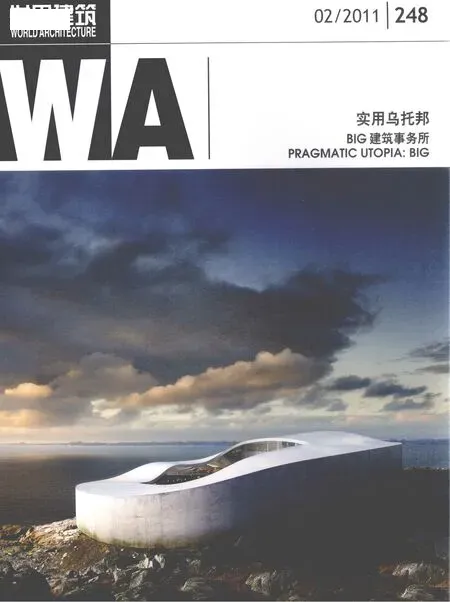BIG!
鲍里斯·布勒曼·延森/Boris Brorman Jensen
项琳斐 译/Translated by XIANG Linfei
BIG也许是丹麦第一家真正“全球本土化”的建筑事务所,既扎根在哥本哈根,又无疑置身于特殊的文化和政治背景下,它也是丹麦最具全球影响的建筑事务所。自有丹麦以来,丹麦建筑师与国界之外的世界就在相互影响。我想提及最近的两位民族英雄式的人物:阿纳·雅各布森和约翰·伍重。 雅各布森因其“丹麦设计”而享誉全球,丹麦人普遍认为,“丹麦设计”对国际风格作出了真正的“丹麦”诠释。设计了悉尼重要地标的伍重,一生大部分时间在国外度过,他被丹麦的文化部奉为“批判性地域主义”创始人之一,阐释出丹麦建筑的精髓。
BIG的“态度”有些许不同。他们当然也同其他建筑事务所一样,应对同样的当代条件,像许多其他“注重实效的建筑师”一样,善于挑战非常理性高效的建筑行业。另一方面,BIG既未被视为对当今国际潮流的最新最重要的丹麦解读者,也并非复兴老牌“丹麦设计”的一个新品牌。我认为,他们是第一次真正成功地对模糊不清的文化边界中新的后民族身份作出(丹麦)解读的代表之一。他们最好的几个项目,明显借鉴了伍重、雅各布森和其他的丹麦建筑偶像。BIG在哥本哈根一地审视世界,不带所谓的“乡愁”。
新建成的上海世博会丹麦馆,是探索用建筑语言充分表达超越“民族”身份的范例。展馆主题“梦想城市”,用安徒生的遗产及其来自19世纪末的浪漫主义情怀,展现了斯堪的纳维亚的幸福生活。不要以为这只是BIG为了向丹麦人民推销方案而略施小伎。全球化无疑向丹麦身份的构想提出挑战,将小美人鱼——我们最神圣的国家象征——搬到中国2010世博会的决定是在国家议会上讨论通过的,之后,BIG才获准允许让她第一次踏上旅途走出丹麦国门。有些政客仍然认为这样的做法亵渎了国家的完整性。我认为,BIG为世界建筑舞台贡献了一种新的文化类型——不以任何夸张的民族符号融入特定的文脉。BIG的许多项目被贴上追求轰动效应的结构表现主义的标签。但是,BIG无意树立纪念碑。
在我看来,BIG重要的贡献之一是,以新的后民族身份为当代建筑定位作出的成熟审慎的尝试。更重要的是,他们这样做的同时,并未向包含一切的中立的政治行为妥协。□
BIG is maybe the first Danish architectural office to be truly ‘glocal’ in the sense of being both anchored in Copenhagen and clearly rooted in a particular cultural and political context-and at the same time being the most globally acting architectural office in Denmark. Danish architects have of course been both influenced by and influencing the world outside of their national borders as long as there has been something called Denmark. Let me just mention two of the most recent national heroes: Arne Jacobsen and J¿rn Utzon. Jacobsen is both internationally known for their‘Danish Design’and nationally respected for their truly‘Danish’interpretations of the international style. Utzon who created Sydney’s outstanding landmark and lived most of his life outside Denmark is canonized by our Cultural Ministry as one of the founding fathers of the so-called‘critical regionalism’defining the very essence of Danish architecture.
BIG’s ‘attitude’is somehow different. BIG is of course operating within the same set of contemporary conditions as any other architectural offices, and like many other‘pragmatic architects’very good at challenging the highly rationalized cost effective building industry. BIG is on the other hand neither regarded as new great national interpreters of current international fluctuations nor a new brand for the revival of the ageing brand of Danish Design. I see them as one of the first real successful (Danish) exponents for a new post-national identity operating within a new set of blurred cultural boundaries. Several of their best projects are explicit referring to Utzon, Jacobsen and other national architectural icons. BIG admits seeing the world from a Copenhagen point of view-and doing so without becoming‘homesick’.
The newly completed Danish Pavilion in Shanghai is a good example of this search for an adequate architectural expression of an identity transgressing ‘the national’. The pavilion’s scheme of ‘Welfairytales’ combines explicit Scandinavian Welfare Statements with the legacy of H.C. Andersen and his aura of national romanticism from the late nineteen-century. Don't be fooled into thinking that it was an easy gimmick for BIG to propose this scheme to the Danish people. Globalization has certainly challenged the very idea of being Danish. The decision to move the Little Mermaid-our most sacred national symbol -to China for the Expo 2010 was debated in the halls of the National Parliament before BIG was given the permission to take her on her first journey ever outside of Danish borders. Some politicians still believe we have violated our national integrity by doing so! I think BIG is offering the global architectural scene a new cultural breed that’s rooted in a particular context without claiming any inflated national trademark. Many of BIG’s projects can be seen and labeled as some kind of structural expressionism reaching out for something spectacular. But BIG does not mean monumentality.
One of BIG’s main contributions is in my view this deliberate effort to position contemporary architecture within a new post-national identity. And most important-they are doing so without ending up in an uncommitted all-inclusive political act of compromise.□


